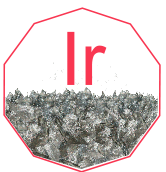Iridium

Iridium (Ir)
General Information
- Symbol: Ir
- Atomic Number: 77
- Atomic Weight: 192.217 u
- Element Category: Transition metal
- Group: 9
- Period: 6
- Block: d-block
Physical Properties
- Appearance: Silvery-white metallic
- Density: 22.56 g/cm³ (second highest of all elements)
- Melting Point: 2446 °C (4435 °F)
- Boiling Point: 4428 °C (8002 °F)
- Phase at STP: Solid
- Electron Configuration: [Xe] 4f¹⁴ 5d⁷ 6s²
- Oxidation States: +6, +4 (most common), +3, +1, 0, -1
Chemical Properties
- Reactivity: Iridium is highly resistant to corrosion, even at high temperatures. It does not react with most acids, but it can be attacked by molten salts such as sodium chloride and sodium cyanide.
- Compounds: Forms compounds such as iridium dioxide (IrO₂), iridium tetroxide (IrO₄), and iridium chloride (IrCl₃).
Uses and Applications
- Alloys: Used in high-strength alloys that can withstand extreme temperatures and corrosive environments, particularly in aircraft engines and deep-sea cables.
- Catalysts: Employed as a catalyst in the chemical industry, especially in the hydrogenation of organic compounds.
- Electronics: Utilized in electrical contacts and electrodes due to its high conductivity and durability.
- Medical Devices: Used in medical devices, including heart pacemakers and cancer treatments, due to its biocompatibility and resistance to corrosion.
- Spark Plugs: Used in the electrodes of spark plugs for its durability and high melting point.
Occurrence and Extraction
- Natural Occurrence: Found in alluvial deposits and ores containing platinum group metals. Often found in conjunction with platinum and osmium.
- Extraction: Extracted as a byproduct of nickel and copper mining. The extraction process involves separating iridium from other platinum group metals through chemical means.
Isotopes
- Stable Isotopes: Iridium-191 and Iridium-193
- Radioactive Isotopes: Several radioactive isotopes, including Iridium-192, used in industrial radiography and cancer treatment.
Safety and Handling
- Hazards: Iridium is generally considered to be of low toxicity, but some iridium compounds can be hazardous if ingested or inhaled.
- Precautions: Handle iridium compounds with appropriate protective equipment and in well-ventilated areas to avoid exposure to dust or fumes.
History
- Discovery: Discovered by Smithson Tennant in 1803.
- Name Origin: Named after the Latin word “iris,” meaning rainbow, due to the colorful nature of its salts.
Additional Facts
- Crystal Structure: Face-centered cubic (fcc)
- Magnetic Properties: Paramagnetic
- Thermal Conductivity: Moderate, about 147 W/m·K
- Electrical Resistivity: About 47.1 nΩ·m at room temperature
Summary
Iridium is a dense, corrosion-resistant transition metal with significant applications in high-strength alloys, catalysts, electronics, and medical devices. It is found in alluvial deposits and platinum group metal ores and is extracted as a byproduct of nickel and copper mining. Iridium’s high melting point, durability, and biocompatibility make it valuable in various industrial and medical fields.
40 Question and Answer Pairs About Iridium
What is the atomic number of Iridium?
- 77
What is the symbol for Iridium?
- Ir
What is the atomic weight of Iridium?
- 192.217 u
In which group of the periodic table is Iridium found?
- Group 9
What period is Iridium in?
- Period 6
What block does Iridium belong to?
- d-block
What is the melting point of Iridium?
- 2446 °C (4435 °F)
What is the boiling point of Iridium?
- 4428 °C (8002 °F)
What is the density of Iridium?
- 22.56 g/cm³
What is the electron configuration of Iridium?
- [Xe] 4f¹⁴ 5d⁷ 6s²
What are the common oxidation states of Iridium?
- +6, +4, +3, +1, 0, -1
What is the appearance of Iridium?
- Silvery-white metallic
Is Iridium reactive with air?
- No, it is highly resistant to corrosion.
Name a compound of Iridium.
- Iridium dioxide (IrO₂)
What is a common use of Iridium in alloys?
- Used in high-strength alloys for aircraft engines.
How is Iridium used in catalysis?
- Employed in the hydrogenation of organic compounds.
What role does Iridium play in electronics?
- Used in electrical contacts and electrodes.
How is Iridium used in medical devices?
- Utilized in heart pacemakers and cancer treatments.
What application does Iridium have in spark plugs?
- Used in electrodes for its durability and high melting point.
Name a mineral that contains Iridium.
- Often found in ores containing platinum group metals.
How is Iridium extracted from ores?
- As a byproduct of nickel and copper mining.
What is the most stable isotope of Iridium?
- Iridium-193
Name a radioactive isotope of Iridium used in cancer treatment.
- Iridium-192
What safety hazard is associated with Iridium compounds?
- Some compounds can be hazardous if ingested or inhaled.
Who discovered Iridium?
- Smithson Tennant
Where does the name Iridium come from?
- From the Latin word “iris,” meaning rainbow.
What is the crystal structure of Iridium?
- Face-centered cubic (fcc)
Is Iridium paramagnetic or diamagnetic?
- Paramagnetic
What is the thermal conductivity of Iridium?
- About 147 W/m·K
What is the electrical resistivity of Iridium at room temperature?
- About 47.1 nΩ·m
What is the primary oxidation state of Iridium?
- +4
Is Iridium found as a free element in nature?
- No, it is found in ores containing platinum group metals.
What is the common name of Iridium chloride?
- IrCl₃
What is a major application of Iridium tetroxide (IrO₄)?
- Used in chemical synthesis and research.
How does Iridium benefit aircraft engines?
- Provides high strength and corrosion resistance.
What is the boiling point of Iridium in Kelvin?
- 4701 K
What group does Iridium belong to in the periodic table?
- Transition metals
What is the natural abundance of Iridium-193?
- About 62.7%
Can Iridium be used in high-temperature applications?
- Yes, due to its high melting point and stability.
What is the key property that makes Iridium valuable in medical devices?
- Its biocompatibility and resistance to corrosion.






